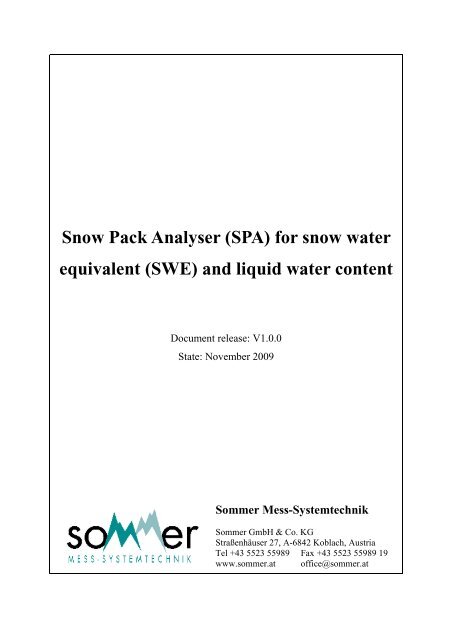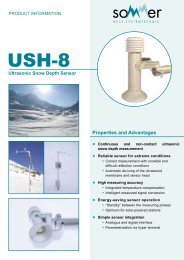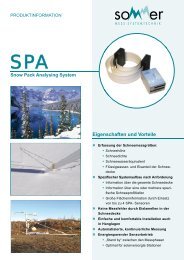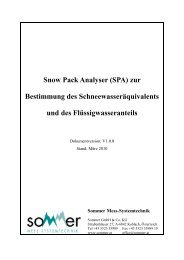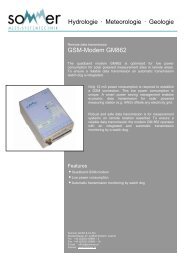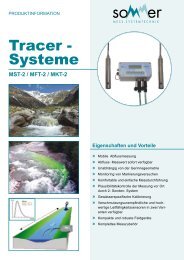for snow water equivalent - Sommer Mess-Systemtechnik
for snow water equivalent - Sommer Mess-Systemtechnik
for snow water equivalent - Sommer Mess-Systemtechnik
You also want an ePaper? Increase the reach of your titles
YUMPU automatically turns print PDFs into web optimized ePapers that Google loves.
Snow Pack Analyser (SPA) <strong>for</strong> <strong>snow</strong> <strong>water</strong><br />
<strong>equivalent</strong> (SWE) and liquid <strong>water</strong> content<br />
Document release: V1.0.0<br />
State: November 2009<br />
<strong>Sommer</strong> <strong>Mess</strong>-<strong>Systemtechnik</strong><br />
<strong>Sommer</strong> GmbH & Co. KG<br />
Straßenhäuser 27, A-6842 Koblach, Austria<br />
Tel +43 5523 55989 Fax +43 5523 55989 19<br />
www.sommer.at office@sommer.at
Snow Pack Analyser (SPA) <strong>for</strong> <strong>snow</strong> <strong>water</strong><br />
<strong>equivalent</strong> (SWE) and liquid <strong>water</strong> content<br />
<strong>Sommer</strong> GmbH & Co KG<br />
Straßenhäuser 27<br />
A-6842 Koblach<br />
Wolfram SOMMER 1 , Reinhard FIEL 1<br />
1 <strong>Sommer</strong> <strong>Mess</strong>-<strong>Systemtechnik</strong>, Strassenhaeuser 27, A-6842 Koblach, Austria<br />
1. ABSTRACT<br />
Improved estimation of the spatial <strong>snow</strong> <strong>water</strong> <strong>equivalent</strong> (SWE) distribution is a key task in<br />
current <strong>snow</strong> research. Quantifying the complex variability of the SWE both in time and<br />
space is essential <strong>for</strong> hydropower production, risk assessment with regard to natural hazards<br />
(avalanches, floods, debris flows), as well as <strong>for</strong> tourism issues in alpine areas.<br />
The Snow Pack Analyser (SPA) is an automatic in-situ measurement system to determine the<br />
characteristics of <strong>snow</strong> covers. Along a flat ribbon sensor the complex capacitances at low<br />
and high frequencies are measured <strong>for</strong> real-time determination of the <strong>snow</strong> density, <strong>snow</strong><br />
<strong>water</strong> <strong>equivalent</strong> and liquid <strong>water</strong> content.<br />
The system can operate with up to four sensors. They are either installed sloping through the<br />
complete <strong>snow</strong> cover or they are arranged horizontal at the ground or defined levels. The<br />
combination of sensors allows to optimize the in<strong>for</strong>mation on specific tasks.<br />
The determination of the liquid <strong>water</strong> content in the <strong>snow</strong> cover is unique. In periods of thaw<br />
the liquid <strong>water</strong> content rises. This enables a <strong>for</strong>ecast of the point in time when the <strong>water</strong> runoff<br />
of the <strong>snow</strong> starts and provides important in<strong>for</strong>mation <strong>for</strong> rationing of reservoirs, flood<br />
prediction or <strong>for</strong> avalanche services to estimate wet slab avalanches.<br />
2. INTRODUCTION<br />
Efficient energy management of hydro power resources requires accurate <strong>for</strong>ecasting of <strong>water</strong><br />
capacity from <strong>snow</strong> melt and run-off. At present the precision of melt <strong>water</strong> prognoses <strong>for</strong><br />
hydro power reservoirs is between 30 and 50 %. As an example, a 10 % gain in <strong>for</strong>ecast<br />
precision at the ‘La Grande Rivière’ catchment in Quebec (Canada) would correspond to a<br />
yield of 2,2 TWh. Improved accuracy of SWE measurements will enhance the economic<br />
efficiency of hydro power plants or drinking <strong>water</strong> reservoirs as well.<br />
Prognosis of melt <strong>water</strong> run-off are relevant <strong>for</strong> flood prevention. Not only mountainous and<br />
alpine regions are affected by floods, but all the areas where rivers are fed by these<br />
catchments. As an example, rapid <strong>snow</strong> melting in the Alps is known to be one reason <strong>for</strong><br />
flooding along the River Rhine valley from Germany to the Netherlands. The precise<br />
monitoring and modeling of SWE, liquid <strong>water</strong> content and the point in time of <strong>water</strong> run-off<br />
will enhance the accuracy of flood predictions and may reduce the danger or effects of natural<br />
catastrophes.<br />
The determination of liquid <strong>water</strong> content in the <strong>snow</strong> cover or in the ground layer of the<br />
<strong>snow</strong> cover is an additional parameter to SWE. It is an indicator <strong>for</strong> avalanche services to<br />
predict wet <strong>snow</strong> avalanches in periods of thaw, especially in spring.<br />
Moreover, the realization of long-term monitoring helps to reduce dangerous and expensive<br />
adoption of human resources in the wintry area.<br />
2 / 10 +43 (0)5523 55989-0<br />
office@sommer.at<br />
www.sommer.at
3. HISTORICAL OVERVIEW<br />
The initial development of the SPA was per<strong>for</strong>med during the international EU-funded<br />
research project SNOWPOWER [1][2][3] in the years 2001 to 2004. The objective of the<br />
project was to increase the precision of filling prognosis to at least 20% by calibrating remote<br />
sense data with ground truth data determined by a new <strong>snow</strong> measurement method.<br />
A new electromagnetic sensor allowing a monitoring of an area of up to 2000 m² was<br />
developed. A PC Software to calculate the <strong>snow</strong> <strong>water</strong> <strong>equivalent</strong> SWE and density from field<br />
data was written. Based on the results and experiences with the laboratory-scale instrument, a<br />
new field measurement instrument was designed.<br />
Field tests were carried out during three winter periods at two measurement sites in<br />
Switzerland and Canada. The measurement site at the Weissfluhjoch in Davos was operated<br />
by the Swiss Federal Institute <strong>for</strong> Snow and Avalanche Research (SLF). It was a high Alpine<br />
test field and harsh winter conditions with air temperatures below -20 °C and wind speeds of<br />
25 to 30 m/s occurred occasionally. Intermediate <strong>snow</strong> melt was rare during the accumulation<br />
phase. The main melts started in April wetting the <strong>snow</strong> pack from its top to the bottom. The<br />
second measurement site was located in the Bras d’Henri <strong>water</strong>shed in Quebec [4]. The<br />
conditions were arctic, the field had a smooth surface with a maximum slope of 0.5 %, and<br />
the <strong>snow</strong> cover remained relatively dry.<br />
Continuous measurements of <strong>snow</strong> depth and <strong>snow</strong> temperatures were conducted at both sites<br />
throughout the entire investigation period. Also air temperature, wind speed, relative<br />
humidity, solar radiation and precipitation were recorded automatically.<br />
At Weissfluhjoch, a detailed <strong>snow</strong> profile description was made twice a month. At these<br />
occasions, <strong>snow</strong> density, SWE, <strong>snow</strong> temperature and the degree of wetness were determined<br />
manually <strong>for</strong> each <strong>snow</strong> layer. Outflow of melt <strong>water</strong> from the <strong>snow</strong> pack was measured<br />
continuously in a lysimeter of 2x2-m ground area.<br />
At the test field in Canada, six <strong>snow</strong> cores were collected twice a week to measure <strong>snow</strong><br />
depth, the mean <strong>snow</strong> density and the SWE. At the same time, a detailed <strong>snow</strong> profile<br />
description was made to determine the liquid <strong>water</strong> content, density and temperature at every<br />
10 cm, using a denoth meter, <strong>snow</strong> density sampling and the dial stem thermometer.<br />
These field test with its accurate data collection resulted in a prototype <strong>for</strong> the measurement<br />
system.<br />
In the years 2004 to 2008 the system was continuously improved by <strong>Sommer</strong> <strong>Mess</strong>-<br />
<strong>Systemtechnik</strong>. The sensor and its installation were re-engineered, the calculation algorithm<br />
was improved, and the measurement and controlling device was designed to calculate the<br />
parameters in situ. In 2009 the SPA system was finalized.<br />
<strong>Sommer</strong> GmbH & Co KG<br />
Straßenhäuser 27<br />
A-6842 Koblach<br />
3 / 10 +43 (0)5523 55989-0<br />
office@sommer.at<br />
www.sommer.at
4. SNOW PACK ANALYSER (SPA)<br />
The SPA is a complete measurement system to detect the <strong>snow</strong> <strong>water</strong> <strong>equivalent</strong>, <strong>snow</strong><br />
density and liquid <strong>water</strong> content of <strong>snow</strong>. The sensor system consists of:<br />
• SPA-Sensor: 6 cm wide and between 3 and 10 m long flat ribbon sensor including<br />
three copper wires.<br />
• Control unit: per<strong>for</strong>ming of measurements, switching between up to four sensors and<br />
calculation of <strong>snow</strong> parameters.<br />
• Ultrasonic <strong>snow</strong> depth sensor<br />
• Mechanical suspension to ensure tight and upright position of the sensors.<br />
Fig. 1: Test site at Weissfluhjoch (Switzerland) Fig. 2: Sloping SPA Sensor entering <strong>snow</strong> cover<br />
4.1. Configurations of the SPA-system<br />
The SPA-system can operate with up to four SPA-sensors. Their quantity and assembly is<br />
related to the desired measurement demands. The sensors are either installed sloping through<br />
the complete <strong>snow</strong> cover, or they are spanned horizontally in the <strong>snow</strong> at defined levels.<br />
4.1.1. Integral measurement of <strong>snow</strong> cover<br />
To measure the integral parameters of the <strong>snow</strong> cover the sensor is installed sloping from a<br />
mast to the ground through the complete <strong>snow</strong> cover. The sloping sensor determines the <strong>snow</strong><br />
density, the <strong>snow</strong> <strong>water</strong> <strong>equivalent</strong> and the ice and liquid <strong>water</strong> contents of the complete <strong>snow</strong><br />
cover. Horizontal sensors can be installed <strong>for</strong> additional in<strong>for</strong>mation.<br />
4.1.2. Snow parameters at defined levels<br />
Horizontally installed sensors determine the liquid <strong>water</strong> content and the <strong>snow</strong> density at<br />
specific levels. Either the sensors are placed at the ground or they are installed at defined<br />
levels.<br />
<strong>Sommer</strong> GmbH & Co KG<br />
Straßenhäuser 27<br />
A-6842 Koblach<br />
4 / 10 +43 (0)5523 55989-0<br />
office@sommer.at<br />
www.sommer.at
4.1.3. Configuration Examples<br />
Common setup Profile setup Areal setup<br />
A sloping sensor and a<br />
horizontal sensor are<br />
installed. The sloping sensor<br />
determines the parameters of<br />
the complete <strong>snow</strong> cover, the<br />
horizontal sensor supplies<br />
additional in<strong>for</strong>mation about<br />
the <strong>snow</strong> conditions close to<br />
the ground layer.<br />
Fields of application:<br />
• Reservoir management<br />
• Flood prediction<br />
<strong>Sommer</strong> GmbH & Co KG<br />
Straßenhäuser 27<br />
A-6842 Koblach<br />
Up to four horizontal sensors<br />
are installed at the ground or<br />
at defined levels. The transit<br />
of <strong>snow</strong>melt <strong>water</strong> through<br />
the <strong>snow</strong> pack can be<br />
detected and a <strong>snow</strong> profile<br />
can be generated.<br />
Fields of application:<br />
• Flood prediction<br />
• Avalanche <strong>for</strong>ecast <strong>for</strong><br />
wet slab avalanches<br />
Fig. 3: Combined assembly Fig. 4: Profile assembly<br />
Four sloping sensors are<br />
installed in star shape. The<br />
measurements of the<br />
individual sensors are<br />
averaged. This results in a<br />
high areal resolution, that<br />
corresponds to the pixel size<br />
of remote sensing data.<br />
Fields of application:<br />
• Calibration of remote<br />
sense data<br />
• Calibration of SWE<br />
numeric models<br />
Fig. 5: Areal assembly with 4<br />
sensors in star shape<br />
5 / 10 +43 (0)5523 55989-0<br />
office@sommer.at<br />
www.sommer.at
4.2. Measurement parameters<br />
The presented measurement data are from the test site at the Weissfluhjoch in Davos<br />
(Switzerland). It is operated by the Swiss Federal Institute <strong>for</strong> Snow and Avalanche Research<br />
(SLF). The sea level of the test site is around 2500 m.<br />
The reference data are from a <strong>snow</strong> pillow of 3x3 m extent. Additional manual profiles were<br />
taken every two weeks during the complete winter season. These data are compared to the<br />
measurement values of the SPA.<br />
SPA Manual measurements Snow pillow<br />
• Snow <strong>water</strong> <strong>equivalent</strong> • Snow <strong>water</strong> <strong>equivalent</strong> • Snow <strong>water</strong> <strong>equivalent</strong><br />
• Snow density<br />
• Snow density<br />
• Liquid <strong>water</strong> content • Snow depth<br />
• Snow depth<br />
4.2.1. Snow <strong>water</strong> <strong>equivalent</strong> (SWE)<br />
The trend of the SWE data measured by the SPA correlates to the reference measurements of<br />
the <strong>snow</strong> pillow and the manual measurements. The relation between SWE and <strong>snow</strong> depth is<br />
con<strong>for</strong>m to the natural process of settlement of the <strong>snow</strong> cover. After <strong>snow</strong> fall the <strong>snow</strong><br />
depth decreases due to the compression of the <strong>snow</strong> cover, but the <strong>snow</strong> <strong>water</strong> <strong>equivalent</strong><br />
remains constant. With the start of the melting period in April the <strong>snow</strong> depth and SWE<br />
decrease.<br />
Fig. 6: SWE data from SPA compared to <strong>snow</strong> pillow and manual measurements.<br />
<strong>Sommer</strong> GmbH & Co KG<br />
Straßenhäuser 27<br />
A-6842 Koblach<br />
6 / 10 +43 (0)5523 55989-0<br />
office@sommer.at<br />
www.sommer.at
4.2.2. Snow density<br />
The density measured by the SPA is similar to the measurements of the <strong>snow</strong> pillow and the<br />
manual data. During <strong>snow</strong> fall the density decreases and in time periods of <strong>snow</strong> compression<br />
the density increases.<br />
Fig. 7: Snow density data from SPA compared to <strong>snow</strong> pillow and manual measurements.<br />
<strong>Sommer</strong> GmbH & Co KG<br />
Straßenhäuser 27<br />
A-6842 Koblach<br />
7 / 10 +43 (0)5523 55989-0<br />
office@sommer.at<br />
www.sommer.at
4.2.3. Liquid <strong>water</strong> content of the <strong>snow</strong> cover<br />
The liquid <strong>water</strong> content stays constant at a relative low level during the winter season until<br />
the middle of April. With the start of the melting season a significant increase occurs. The<br />
peaks at the end of the data show daily variations, the liquid <strong>water</strong> content rises during day<br />
time due to melting processes that result in <strong>water</strong> run-off from the <strong>snow</strong> cover, which in<br />
return reduces the liquid <strong>water</strong> in the <strong>snow</strong>.<br />
Fig. 8: Ice and liquid <strong>water</strong> content of the <strong>snow</strong> cover.<br />
<strong>Sommer</strong> GmbH & Co KG<br />
Straßenhäuser 27<br />
A-6842 Koblach<br />
8 / 10 +43 (0)5523 55989-0<br />
office@sommer.at<br />
www.sommer.at
4.2.4. Forecast of <strong>water</strong> run-off<br />
At the begin of March (point A) the <strong>snow</strong> cover is compressed while the SWE stays constant.<br />
The start of the melting period is defined by the decrease of the SWE (point B) when the<br />
<strong>water</strong> run-off of the <strong>snow</strong> cover starts. A significant increase of liquid <strong>water</strong> content is<br />
measured prior to the start of melting period (point C). The measurement of liquid <strong>water</strong><br />
provides a <strong>for</strong>ecast of the point in time of the <strong>water</strong> run-off.<br />
Fig. 9: Determination of the starting point of run-off from the <strong>snow</strong> cover.<br />
<strong>Sommer</strong> GmbH & Co KG<br />
Straßenhäuser 27<br />
A-6842 Koblach<br />
A<br />
C<br />
B<br />
9 / 10 +43 (0)5523 55989-0<br />
office@sommer.at<br />
www.sommer.at
5. CONCLUSION<br />
The SPA-system is an in-situ measurement system <strong>for</strong> <strong>snow</strong> density and <strong>snow</strong> <strong>water</strong><br />
<strong>equivalent</strong>. The unique determination of the liquid <strong>water</strong> content enables a wide field of new<br />
applications. The possibility to arrange up to four SPA-sensors in sloping or horizontal<br />
installation enables to optimize the in<strong>for</strong>mation depending on demands.<br />
The advantages of the SPA are:<br />
• In-situ measurement of <strong>snow</strong> <strong>water</strong> <strong>equivalent</strong> (SWE) and <strong>snow</strong> density<br />
• Unique in-situ determination of liquid <strong>water</strong> content of the <strong>snow</strong> cover which enables<br />
new applications<br />
• Accurate <strong>for</strong>ecast of the point in time when the <strong>water</strong> run-off of the <strong>snow</strong> starts to<br />
improve management of reservoirs, flood prediction and avalanche <strong>for</strong>ecast.<br />
• Accurate measurement even <strong>for</strong> large amounts of <strong>snow</strong> and different type of <strong>snow</strong><br />
conditions.<br />
• Measurement at large areas to determine an integral <strong>snow</strong> parameters <strong>for</strong> calibration<br />
of numeric models or remote sensing<br />
• Realization of long-term monitoring instead of manual measurements<br />
• Simple installation even at hillsides<br />
6. REFERENCES:<br />
[1] Stähli, M., Völksch, I., <strong>Sommer</strong>, W., und Meister, R. SNOWPOWER – ein neuer<br />
automatischer Sensor für Schneewasserwert-<strong>Mess</strong>ungen. Wasser-Energie-Luft, 2006 /<br />
Heft 2<br />
[2] Stähli, M., Gustafsson, D., Stacheder, M., <strong>Sommer</strong>, W., Schneebeli, M., Test of a new<br />
in-situ <strong>snow</strong> sensor <strong>for</strong> validation of remote sensing images at a high alpine site in<br />
eastern Switzerland, 2004<br />
[3] http://www.project-<strong>snow</strong>power.de<br />
[4] Niang, M., Bernier, M., Gauthier, Y., Fortin, G., Van Bochove, E., Stacheder, M.,<br />
Brandelik, A., On the Validation of Snow Densities Derived from SNOWPOWER<br />
Probes in a Temperate Snow Cover in Eastern Canada: First Results, 2003<br />
7. CONTACT AND FURTHER INFORMATION<br />
<strong>Sommer</strong> GmbH & Co KG<br />
Straßenhäuser 27<br />
A-6842 Koblach<br />
Austria<br />
Tel +43 5523 55989 – 0<br />
Fax +43 5523 55989-19<br />
office@sommer.at<br />
www.sommer.at<br />
<strong>Sommer</strong> GmbH & Co KG<br />
Straßenhäuser 27<br />
A-6842 Koblach<br />
10 / 10 +43 (0)5523 55989-0<br />
office@sommer.at<br />
www.sommer.at


